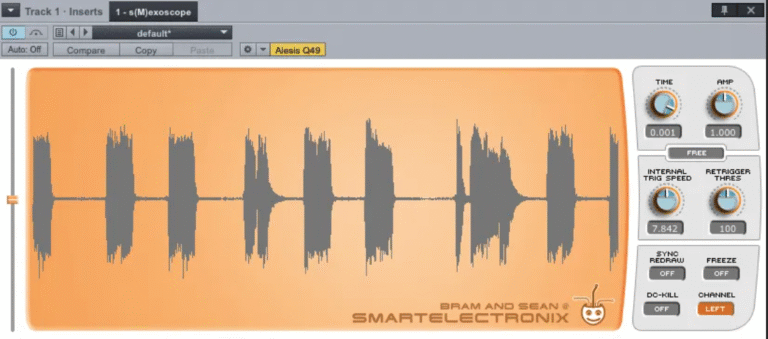Why You Should Upgrade Your Audio Interface
If you’re serious about music production, upgrading your audio interface can make a huge difference. I recently made the switch to the Apollo interface, and here are three key reasons why you might want to upgrade, too.
Reason 1: High-Quality Converters
One of the first things you’ll notice with a better audio interface is the converters—these are the components that transform analog sound into digital and back again. Compared to my old Scarlett 2i4, the Apollo’s converters are a major step up.
The difference is especially noticeable in the bass frequencies. When I mix, the low end sounds much clearer and more defined, and the overall audio feels more balanced and precise. This level of detail makes a huge impact when I’m finishing my tracks, ensuring my mixes translate perfectly on any system.
Reason 2: Better Preamps
Next, let’s talk about the preamps. Preamplifiers are essential because they amplify the signal from your microphone or instrument to a usable level. Apollo’s preamps are on another level compared to entry-level interfaces like the Scarlett 2i4.
These preamps deliver a cleaner and richer sound. They capture more detail with very low noise and distortion, which means your recordings sound much closer to the original performance. Whether I’m recording vocals or an acoustic guitar, the sound feels more natural and professional, ready for mixing without needing too much cleanup.
Reason 3: Zero Latency Plugins and Built-In DSP
Finally, the game-changer: zero-latency recording with plugins. This is possible because the Apollo uses a Thunderbolt 3 connection, which offers incredibly fast data transfer. This eliminates any delay (latency) while recording, even when using heavy effects.
But that’s not all—Apollo interfaces come with a built-in DSP (Digital Signal Processor). Think of it like a mini-computer inside the interface that processes your plugins. Instead of using your computer’s CPU, the DSP handles the workload.
There are different DSP versions, like Duo Core and Quad Core. The more cores you have, the more plugins you can run at once. This is a massive advantage for big sessions where you need multiple effects without your computer slowing down or crashing.
With the Apollo, I can record in real-time with professional plugins and mix large projects without overloading my system. It’s a total game-changer for serious music production.
If I’ve convinced you and you find yourself in the same situation, buy it from this link: https://amzn.to/4gGDN4D
Final Thoughts
Upgrading your audio interface can completely change the way you work. From clearer sound with better converters to cleaner recordings with top-notch preamps, and real-time processing with DSP, the benefits are huge. If you want to take your music production to the next level, it might be time to make the switch.
The Apollo Twin X by Universal Audio is a benchmark in audio interfaces, offering exceptional sound quality, real-time plugin processing, and a professional-grade workflow for musicians, producers, and content creators. Here’s an in-depth look at why this interface is a favorite among audio professionals:
Build Quality and Design
The Apollo Twin X boasts a sleek aluminum chassis that not only looks premium but is also built to last. Its compact size makes it perfect for both desktop setups and portable use. The intuitive controls—with a large rotary knob and tactile buttons—ensure easy operation, whether you’re adjusting gain or navigating settings mid-session.
Pristine Audio Quality
The sound quality of the Apollo Twin X is industry-leading:
- High-Resolution Audio: Supports up to 24-bit/192 kHz, capturing every nuance of your recordings.
- Unison Technology: The mic preamps emulate iconic analog hardware like Neve, API, and SSL preamps, delivering unmatched warmth and character.
- 127 dB Dynamic Range: Provides exceptional headroom and ultra-low noise for crystal-clear recordings.
Features That Stand Out
Real-Time UAD Processing
The Apollo Twin X’s built-in DSP enables you to use UAD plugins in real-time during recording. With the UA Console app, you can apply EQ, compression, reverb, or any other effect directly in your signal chain without introducing latency.
Inputs and Outputs
- 2 Combo Mic/Line Inputs: Perfect for vocals, instruments, and line-level devices.
- Hi-Z Input: For guitars or bass.
- ADAT Expandability: Expand your setup with up to eight additional inputs.
- Line Outputs: Ideal for connecting to monitors or outboard gear.
Thunderbolt 3 Connectivity
The Twin X offers fast and reliable Thunderbolt 3 connections, ensuring smooth performance with both macOS and Windows systems.
Streaming and Content Creation Workflow
The Apollo Twin X simplifies workflows for streamers and content creators, especially compared to simpler interfaces like the Scarlett series.
- UA Console Software: No need to process audio in OBS or your DAW. With the Apollo, you can insert EQ, dynamics, and limiter plugins directly in the Console app during recording, bypassing OBS’s limitations.
- Real-Time Monitoring: Enjoy zero-latency monitoring while applying effects.
- Professional Sound: The interface ensures your audio is polished before it even reaches your software, saving time in post-production.
Pros and Cons
Pros
- Top-tier sound quality and dynamic range.
- Real-time plugin processing with UAD’s premium plugins.
- Compact and robust design ideal for professionals on the go.
- ADAT expandability for future upgrades.
- Intuitive and streamlined workflow for recording, streaming, and mixing.
Cons
- Pricey, especially compared to entry-level interfaces.
- Requires Thunderbolt 3, which may not be available on all systems.
- Limited DSP power on the Solo/Duo versions for heavier plugin chains.
Final Verdict
The Apollo Twin X is a standout audio interface, blending professional-grade audio fidelity with modern functionality. It’s an ideal choice for those seeking to elevate their recordings, whether you’re a producer, streamer, or musician. While it carries a higher price tag, its superior sound quality and real-time processing capabilities make it a worthwhile investment for serious creators.




